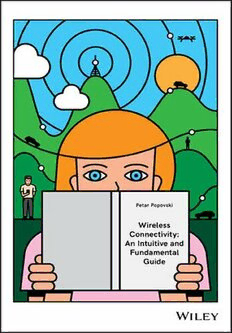Table Of ContentWireless Connectivity
Wireless Connectivity
An Intuitive and Fundamental Guide
Petar Popovski
DepartmentofElectronicSystems
AalborgUniversity,Denmark
Thiseditionfirstpublished2020
©2020JohnWiley&SonsLtd
Allrightsreserved.Nopartofthispublicationmaybereproduced,storedinaretrievalsystem,or
transmitted,inanyformorbyanymeans,electronic,mechanical,photocopying,recordingorotherwise,
exceptaspermittedbylaw.Adviceonhowtoobtainpermissiontoreusematerialfromthistitleisavailable
athttp//www.wiley.com/go/permissions.
TherightofPetarPopovskitobeidentifiedastheauthorofthisworkhasbeenassertedinaccordance
withlaw.
RegisteredOffices
JohnWiley&Sons,Inc.,111RiverStreet,Hoboken,NJ07030,USA
JohnWiley&SonsLtd,TheAtrium,SouthernGate,Chichester,WestSussex,PO198SQ,UK
EditorialOffice
TheAtrium,SouthernGate,Chichester,WestSussex,PO198SQ,UK
Fordetailsofourglobaleditorialoffices,customerservices,andmoreinformationaboutWileyproducts
visitusatwww.wiley.com.
Wileyalsopublishesitsbooksinavarietyofelectronicformatsandbyprint-on-demand.Somecontentthat
appearsinstandardprintversionsofthisbookmaynotbeavailableinotherformats.
LimitofLiability/DisclaimerofWarranty
Whilethepublisherandauthorshaveusedtheirbesteffortsinpreparingthiswork,theymakeno
representationsorwarrantieswithrespecttotheaccuracyorcompletenessofthecontentsofthisworkand
specificallydisclaimallwarranties,includingwithoutlimitationanyimpliedwarrantiesofmerchantability
orfitnessforaparticularpurpose.Nowarrantymaybecreatedorextendedbysalesrepresentatives,written
salesmaterialsorpromotionalstatementsforthiswork.Thefactthatanorganization,website,orproduct
isreferredtointhisworkasacitationand/orpotentialsourceoffurtherinformationdoesnotmeanthat
thepublisherandauthorsendorsetheinformationorservicestheorganization,website,orproductmay
provideorrecommendationsitmaymake.Thisworkissoldwiththeunderstandingthatthepublisheris
notengagedinrenderingprofessionalservices.Theadviceandstrategiescontainedhereinmaynotbe
suitableforyoursituation.Youshouldconsultwithaspecialistwhereappropriate.Further,readersshould
beawarethatwebsiteslistedinthisworkmayhavechangedordisappearedbetweenwhenthisworkwas
writtenandwhenitisread.Neitherthepublishernorauthorsshallbeliableforanylossofprofitorany
othercommercialdamages,includingbutnotlimitedtospecial,incidental,consequential,orother
damages.
LibraryofCongressCataloging-in-PublicationDataappliedfor
HBISBN:9780470683996
CoverDesign&Image:©PeterGregson
Setin9.5/12.5ptSTIXTwoTextbySPiGlobal,Chennai,India
10 9 8 7 6 5 4 3 2 1
Inmemoryofmyfather,theunshakeableoptimist.
vii
Contents
Foreword xv
Acknowledgments xix
Acronyms xxi
1 AnEasyIntroductiontotheSharedWirelessMedium 3
1.1 HowtoBuildaSimpleModelforWirelessCommunication 4
1.1.1 WhichFeaturesWeWantfromtheModel 4
1.1.2 CommunicationChannelwithCollisions 4
1.1.3 Trade-offsintheCollisionModel 7
1.2 TheFirstContact 9
1.2.1 HierarchyHelpstoEstablishContact 9
1.2.2 WirelessRendezvouswithoutHelp 11
1.2.3 RendezvouswithFull-DuplexDevices 12
1.3 MultipleAccesswithCentralizedControl 12
1.3.1 AFrameforTimeDivision 13
1.3.2 FrameHeaderforFlexibleTimeDivision 14
1.3.3 ASimpleTwo-WaySystemthatWorksUndertheCollisionModel 15
1.3.4 StillNotaPracticalTDMASystem 18
1.4 MakingTDMADynamic 19
1.4.1 Circuit-SwitchedversusPacket-SwitchedOperation 19
1.4.2 DynamicAllocationofResourcestoUsers 20
1.4.3 ShortControlPacketsandtheIdeaofReservation 22
1.4.4 Half-DuplexversusFull-DuplexinTDMA 24
1.5 ChapterSummary 25
1.6 FurtherReading 25
1.7 ProblemsandReflections 26
2 RandomAccess:HowtoTalkinCrowdedDarkRoom 29
2.1 FramedALOHA 30
2.1.1 RandomizationthatMaximizestheALOHAThroughput 32
2.2 Probing 35
2.2.1 CombiningALOHAandProbing 39
viii Contents
2.3 CarrierSensing 39
2.3.1 RandomizationandSpectrumSharing 39
2.3.2 AnIdleSlotisCheap 41
2.3.3 FeedbacktotheTransmitter 43
2.4 RandomAccessandMultipleHops 45
2.4.1 UseofReservationPacketsinMulti-Hop 47
2.4.2 MultipleHopsandFull-Duplex 47
2.5 ChapterSummary 48
2.6 FurtherReading 48
2.7 ProblemsandReflections 48
3 AccessBeyondtheCollisionModel 53
3.1 DistanceGetsintotheModel 53
3.1.1 CommunicationDegradesastheDistanceIncreases 53
3.1.2 HowtoMaketheResultofaCollisionDependentontheDistance 55
3.2 SimplifiedDistanceDependence:ADoubleDiskModel 57
3.3 DownlinkCommunicationwiththeDoubleDiskModel 58
3.3.1 ACautiousExampleofaDesignthatReachestheLimitsoftheModel 61
3.4 UplinkCommunicationwiththeDoubleDiskModel 62
3.4.1 UplinkthatUsesMulti-PacketReception 64
3.4.2 BufferedCollisionsforFutureUse 64
3.4.3 ProtocolsthatUsePacketFractions 66
3.5 UnwrappingthePackets 68
3.6 ChapterSummary 69
3.7 FurtherReading 70
3.8 ProblemsandReflections 70
4 TheNetworkingCake:LayeringandSlicing 75
4.1 LayeringforaOne-WayLink 75
4.1.1 ModulesandtheirInterconnection 75
4.1.2 ThreeImportantConceptsinLayering 77
4.1.3 AnExampleofaTwo-LayerSystem 78
4.2 LayersandCross-Layer 79
4.3 ReliableandUnreliableServicefromaLayer 81
4.4 BlackBoxFunctionalityforDifferentCommunicationModels 84
4.5 StandardLayeringModels 86
4.5.1 ConnectionversusConnectionless 87
4.5.2 FunctionalityoftheStandardLayers 88
4.5.3 AVeryBriefLookattheNetworkLayer 89
4.6 AnAlternativeWirelessLayering 91
4.7 Cross-LayerDesignforMultipleHops 92
4.8 SlicingoftheWirelessCommunicationResources 94
4.8.1 Analog,Digital,Sliced 94
4.8.2 APrimeronWirelessSlicing 96
4.8.2.1 OrthogonalWirelessSlicing 96
Contents ix
4.8.2.2 Non-OrthogonalWirelessSlicing 98
4.9 ChapterSummary 100
4.10 FurtherReading 100
4.11 ProblemsandReflections 100
5 PacketsUndertheLookingGlass:SymbolsandNoise 105
5.1 Compression,Entropy,andBit 105
5.1.1 ObtainingDigitalMessagesbyCompression 106
5.1.2 ABitofInformation 106
5.2 BasebandModulesoftheCommunicationSystem 107
5.2.1 MappingBitstoBasebandSymbolsunderSimplifyingAssumptions 108
5.2.2 ChallengingtheSimplifyingAssumptionsabouttheBaseband 109
5.3 SignalConstellationsandNoise 110
5.3.1 ConstellationPointsandNoiseClouds 110
5.3.2 ConstellationswithLimitedAveragePower 113
5.3.3 BeyondtheSimpleSetupforSymbolDetection 114
5.3.4 Signal-to-NoiseRatio(SNR) 116
5.4 FromBitstoSymbols 117
5.4.1 BinaryPhaseShiftKeying(BPSK) 117
5.4.2 QuaternaryPhaseShiftKeying(QPSK) 118
5.4.3 ConstellationsofHigherOrder 119
5.4.4 GeneralizedMappingtoManySymbols 122
5.5 Symbol-LevelInterferenceModels 123
5.5.1 AdvancedTreatmentofCollisionsbasedonaBasebandModel 124
5.6 WeakandStrongSignals:NewProtocolPossibilities 126
5.6.1 RandomizationofPower 127
5.6.2 OtherGoodiesfromtheBasebandModel 129
5.7 HowtoSelecttheDataRate 130
5.7.1 ASimpleRelationbetweenPacketErrorsandDistance 130
5.7.2 AdaptiveModulation 132
5.8 SuperpositionofBasebandSymbols 134
5.8.1 BroadcastandNon-OrthogonalAccess 135
5.8.2 UnequalErrorProtection(UEP) 137
5.9 CommunicationwithUnknownChannelCoefficients 138
5.10 ChapterSummary 141
5.11 FurtherReading 142
5.12 ProblemsandReflections 142
6 AMathematicalViewonaCommunicationChannel 147
6.1 AToyExample:ThePigeonCommunicationChannel 147
6.1.1 SpecificationofaCommunicationChannel 149
6.1.2 ComparisonoftheInformationCarryingCapabilityofMathematical
Channels 150
6.1.3 AssumptionsandNotations 151
x Contents
6.2 AnalogChannelswithGaussianNoise 151
6.2.1 GaussianChannel 152
6.2.2 OtherAnalogChannelsBasedontheGaussianChannel 152
6.3 TheChannelDefinitionDependsonWhoKnowsWhat 154
6.4 UsingAnalogtoCreateDigitalCommunicationChannels 158
6.4.1 CreatingDigitalChannelsthroughGrayMapping 158
6.4.2 CreatingDigitalChannelsthroughSuperposition 161
6.5 TransmissionofPacketsoverCommunicationChannels 163
6.5.1 LayeringPerspectiveoftheCommunicationChannels 163
6.5.2 HowtoObtainThroughputthatisnotZero 164
6.5.3 AsynchronousPacketsandTransmissionof“Nothing” 167
6.5.4 PacketTransmissionoveraTernaryChannel 169
6.6 ChapterSummary 171
6.7 FurtherReading 171
6.8 ProblemsandReflections 172
7 CodingforReliableCommunication 177
7.1 SomeCodingIdeasfortheBinarySymmetricChannel 177
7.1.1 AChannelBasedonRepetitionCoding 177
7.1.2 ChannelBasedonRepetitionCodingwithErasures 179
7.1.3 CodingBeyondRepetition 181
7.1.4 AnIllustrativeComparisonoftheBSCBasedChannels 182
7.2 GeneralizationoftheCodingIdea 183
7.2.1 MaximumLikelihood(ML)Decoding 187
7.3 LinearBlockCodesfortheBinarySymmetricChannel 188
7.4 CodedModulationasaLayeredSubsystem 192
7.5 RetransmissionasaSupplementtoCoding 194
7.5.1 FullPacketRetransmission 195
7.5.2 PartialRetransmissionandIncrementalRedundancy 197
7.6 ChapterSummary 199
7.7 FurtherReading 199
7.8 ProblemsandReflections 199
8 Information-TheoreticViewonWirelessChannelCapacity 203
8.1 ItStartswiththeLawofLargeNumbers 203
8.2 AUsefulDigressionintoSourceCoding 204
8.3 PerfectlyReliableCommunicationandChannelCapacity 207
8.4 MutualInformationandItsInterpretations 209
8.4.1 FromaLocaltoaGlobalProperty 209
8.4.2 MutualInformationinSomeActualCommunicationSetups 211
8.5 TheGaussianChannelandthePopularCapacityFormula 214
8.5.1 TheConceptofEntropyinAnalogChannels 214
8.5.2 TheMeaningof“Shannon’sCapacityFormula” 215
8.5.3 SimultaneousUsageofMultipleGaussianChannels 217
Contents xi
8.6 CapacityofFadingChannels 219
8.6.1 ChannelStateInformationAvailableattheTransmitter 219
8.6.2 Example:WaterFillingforBinaryFading 221
8.6.3 WaterFillingforContinuouslyDistributedFading 222
8.6.4 FastFadingandFurtherRemarksonChannelKnowledge 223
8.6.5 CapacityWhentheTransmitterDoesNotKnowtheChannel 225
8.6.5.1 ChannelwithBinaryInputsandBinaryFading 225
8.6.5.2 ChannelswithGaussianNoiseandFading 229
8.6.6 ChannelEstimationandKnowledge 230
8.7 ChapterSummary 232
8.8 FurtherReading 233
8.9 ProblemsandReflections 233
9 TimeandFrequencyinWirelessCommunications 237
9.1 ReliableCommunicationRequiresTransmissionofDiscreteValues 237
9.2 CommunicationThroughaWaveform:AnExample 239
9.3 EntertheFrequency 242
9.3.1 InfinitelyLongSignalsandTrueFrequency 242
9.3.2 BandwidthandTime-LimitedSignals 245
9.3.3 ParallelCommunicationChannels 247
9.3.4 HowFrequencyAffectstheNotionofMultipleAccess 248
9.4 NoiseandInterference 250
9.4.1 SignalPowerandGaussianWhiteNoise 250
9.4.2 InterferencebetweenNon-OrthogonalFrequencies 252
9.5 PowerSpectrumandFourierTransform 255
9.6 FrequencyChannels,Finally 258
9.6.1 CapacityofaBandlimitedChannel 259
9.6.2 CapacityandOFDMTransmission 261
9.6.3 FrequencyforMultipleAccessandDuplexing 261
9.7 CodeDivisionandSpreadSpectrum 263
9.7.1 SharingSynchronizedResourceswithOrthogonalCodes 263
9.7.2 WhyGoThroughtheTroubleofSpreading? 265
9.7.3 MimickingtheNoiseandCovertCommunication 268
9.7.4 RelationtoRandomAccess 269
9.8 ChapterSummary 270
9.9 FurtherReading 270
9.10 ProblemsandReflections 270
10 SpaceinWirelessCommunications 275
10.1 CommunicationRangeandCoverageArea 276
10.2 TheMythaboutFrequenciesthatPropagateBadlyinFreeSpace 278
10.3 TheWorldViewofanAntenna 280
10.3.1 AntennaDirectivity 280
10.3.2 DirectivityChangestheCommunicationModels 282

